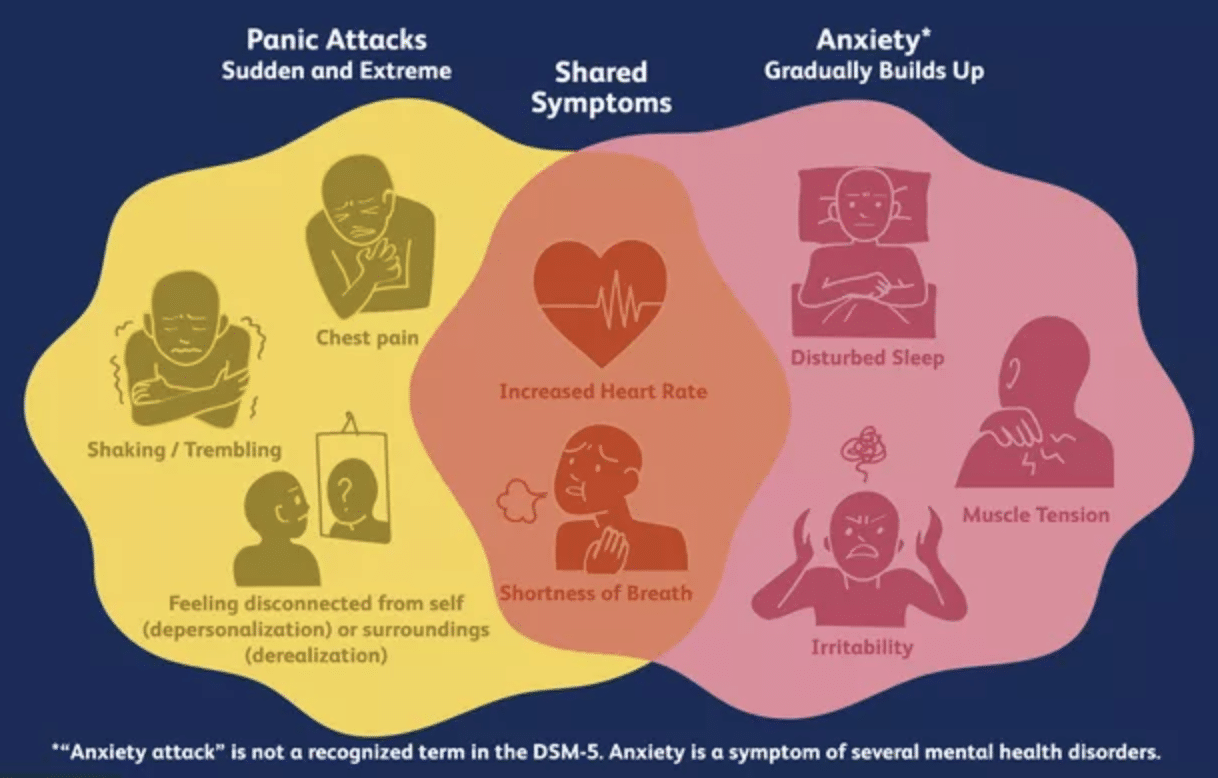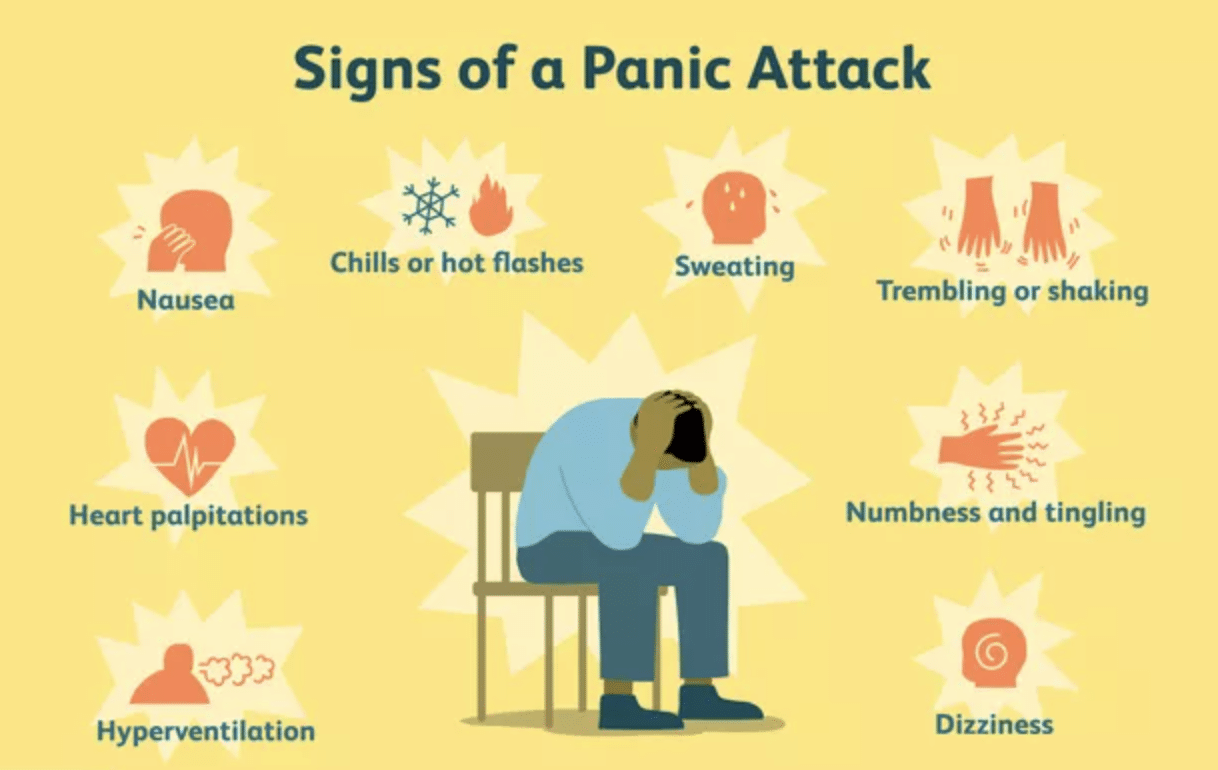You might hear the terms “anxiety attack” and “panic attack” used interchangeably, which is understandable given that they share some common symptoms. In practice, however, panic and anxiety have different features, and behavioral health professionals use these terms for specific symptoms and disorders.
Panic attacks are an abrupt surge of intense fear or discomfort accompanied by other physical and mental symptoms.1 Anxiety, on the other hand, is part of the emotional and protective responses hardwired into the human body. It is when anxiety is excessive or gets in the way of your everyday life that there is cause for concern.
Clinical Differences
Professionals who treat mental health conditions base a diagnosis on criteria found in the Diagnostic and Statistical Manual of Mental Disorders (5th edition), known as the DSM-5. Though anxiety and panic attacks may feel similar, the differences outlined in the DSM help identify and distinguish them. The definitions and diagnostic criteria in the DSM-5 guide a healthcare provider to make a diagnosis and classify your condition.
The differences between panic and anxiety are best described in terms of the intensity of the symptoms and the length of time the main symptoms occur. Panic attacks usually peak at around 10 minutes while anxiety can last for months.
Panic attacks are mainly associated with a condition known as panic disorder, though they may occur with other psychiatric disorders. It is also possible to have a panic attack if you have no disorder.2
They differ from anxiety in that they are accompanied by symptoms such as:
- A sense of detachment from the world (derealization)
- A detachment from the self (depersonalization)
- The fear of dying or losing control
The term “anxiety attack,” on the other hand, is not defined in the DSM-5. Rather, “anxiety” is used to describe a core feature of several illnesses identified under the headings of anxiety disorders, obsessive-compulsive disorders, and trauma- and stressor-related disorders.
Anxiety is distinguished from a panic attack in that it includes symptoms such as apprehension and worry, but without the extreme fear and sense of detachment that occurs during a panic attack.
Is it Panic or Anxiety?
Example 1
Your social media feed is full of divisive political talk, there are risks of layoffs due to the decimated economy, and there seems to be no clear end in sight.
In the meantime, you have a project deadline tomorrow.
You feel stressed, squeezed, and overwhelmed. You feel tired and worried, unsure about what the future holds, whether you will get done what you need to do, whether you will help your child cope with it all.
Example 2
It is the middle of the night, and you can’t go to sleep. Your thoughts are racing.
What if …? Your mind can’t stay away from the stream of catastrophic worries that keep circling. Your heart pounds. You’re exhausted. You look at the clock—it’s 3:15am.
Example 3
You’re out with your friends at a restaurant, laughing at a joke one has just told.
All of a sudden, there’s a sensation of your blood rushing to your ears, and your heart rate accelerates. Your hands are clammy, and you wonder whether you’re having a heart attack.
Intense fear grips you, and you feel the urge to leave, to escape the situation. You get up without excusing yourself and run for the door.
Well, Which is Which?
Understanding the differences between naturally occurring anxiety, worry, and panic can help people take steps to address their feelings. Knowledge of these conditions can also help individuals recognize if their condition is serious enough to require treatment.
Example 1: A Normal Level of Anxiety
This describes an individual experiencing very natural, understandable anxiety around a challenging situation. Fear of an uncertain future, memories of a difficult past, threats (both real and perceived), and confusion about the world around us are all triggers for anxiety.
Example 2: A Concerning Level of Anxiety
The second example describes an individual experiencing worry and depending on the level of distress and functional impairment caused, may indicate that treatment for anxiety might be helpful.
Worry is a mental activity that, somewhat counterintuitively, functions as an anxiety avoidance strategy, though it’s one that doesn’t work very well. It’s hard to simply stop worrying.
Typically, when individuals find themselves stuck in a worry cycle, learning acceptance and mindfulness skills from acceptance-based behavior therapy can be useful.
Example 3: Panic
This is an individual experiencing a panic attack. Panic attacks are rarer and more severe than anxiety. They can come out of the blue, without warning or provocation.
People having panic attacks can experience shortness of breath, dizziness, nausea, and numbness. Some shake and sweat.
Individuals struggling with panic often are very watchful for the physical sensations that might be harbingers of panic and avoid places where panic attacks may have occurred in the past. Sometimes those struggling with panic avoid leaving their homes at all.
The good news is that panic disorder is highly treatable with exposure therapy.
Have Anxiety or Panic? You’re Far From Alone
The Anxiety and Depression Association of America reports that some 40 million U.S. adults experience significant anxiety each year, with more than 28.8% of adults experiencing clinically meaningful anxiety symptoms.
That’s nearly one in three people.
Anxiety is America’s most common mental illness and can be treated effectively. However, only around one third of those with the condition seek professional help.
Anxiety disorders are hereditary, which means that if you have a relative with anxiety, you are more likely to experience it yourself.
Panic disorder, which is a type of anxiety disorder, affects about 4.7% of U.S. adults at some point in their lives, according to the National Institute of Mental Health.
The Best Treatment for Anxiety? Facing Your Fears
We know that anxiety disorders are maintained by avoidance. For example, if you are afraid of dogs, you avoid them. While this keeps you safe in the moment, it also feeds your fear because it takes away any opportunities you may have to learn more about dogs—that while some bite, others are cuddly, empathic, and silly.
If you are experiencing anxiety that has been prolonged, causes you significant distress, or impairs your ability to function, it may be time to seek help. The good news is that effective treatment is available in a variety of forms.
Although there are different ways to approach anxiety treatment, we know that exposure therapy has proven to be incredibly helpful. At the heart of the approach is tackling problematic avoidance and increasing willingness to experience discomfort.
Sometimes medications are used to augment exposure-based treatment for anxiety. Serotonin reuptake inhibitors (SRIs) and other antidepressants may be useful here to help individuals better engage in exposure-based work.
Newer treatments, like mindfulness-based cognitive therapy, meditation, and acceptance-based approaches, like acceptance and commitment therapy, have also been shown to be effective.
Finally, maintaining healthy behaviors, such as regular physical exercise, good sleep hygiene, and avoiding the use of alcohol or caffeine, can also be helpful.
What You Need to Know About Panic Disorders
Unlike anxiety, which often has clear triggers, panic attacks occur suddenly and unexpectedly and typically only last for a few minutes.
Those who experience panic attacks have reported lightheadedness, chest pain, hot flashes, chills, and stomach discomfort. Some say they feel like they were being choked or suffocated. Others say an attack made them feel “detached from reality.”
Occasional panic attacks can happen to anyone, although for some individuals, they occur more frequently and cause significant distress and impairment.
Evidence-based treatments for panic disorder are similar to those for anxiety and involve exposure-based treatment. Mindfulness and meditation can also be useful to curb stress and promote increased psychological flexibility.
Sometimes medications are used to augment behavioral treatments for panic disorder and include beta-blockers, selective serotonin reuptake inhibitors, and serotonin-norepinephrine reuptake inhibitors.
If you have had continued panic attacks, you may need to seek professional help. Your doctor will ask about your symptoms, other mental health and medical conditions, and whether you are experiencing abnormal stress or anxiety. Blood tests and a heart examination may also be required.
Both panic and anxiety are treatable and manageable—even when they may feel as if they are out of your control.



